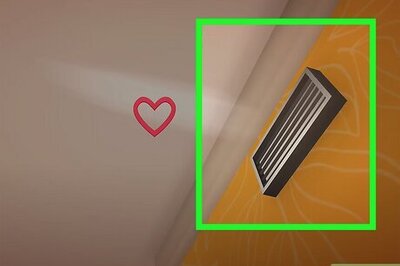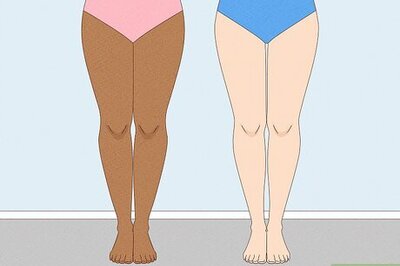
views
With Rahul Gandhi still seems reluctant to take over reins of his party ahead of 2024 Lok Sabha elections, the Congress has announced the elections for its president in October. Congress, which often faced allegations of dynastic politics due to the control of the Gandhi family over its affairs, held its last election for the president post in November 2000.
The Congress Working Committee (CWC)– the highest decision-making body of the Congress – met on Sunday to approve the election for its president post on October 17. The results for the elections are to be announced on October 19.
In the history of over 130-year-old party, Sonia Gandhi remains the longest serving party president. She took over party’s control from Sitaram Kesri following the 1998 Lok Sabha polls and has been at the helm since then barring a two-year period between 2017-19 when Rahul Gandhi became Congress president.
The grand old party has seen several party presidents since 1885 from Womesh Chandra Bonnerjee, Dadabhai Naoroji, Madan Mohan Malaviya, Mahatma Gandhi, Jawaharlal Nehru, Vallabhbhai Patel Indira Gandhi, Rajiv Gandhi to Rahul Gandhi.
As Congress gears up to choose its next leader, here’s a look at those leaders who served as party presidents so far since India’s independence.
J B Kripalani – 1947
J B Kripalani, also known as Acharya Kripalani, was the Congress president when India won its freedom from British colonial rule. He was involved in party’s affairs in several movements for country’s independence. Later, he left Congress to form the Kisan Majdoor Praja Party. He was elected to the Lok Sabha four times.
Pattabhi Sitaramayya (1948-49)
With then Prime Minister Jawaharlal Nehru’s support, Sitaramayya won the Congress presidential elections in 1948. He also served as the Governor of Madhya Pradesh from 1952-57. Sitaramayya was one of leaders who demanded for the separate state of Andhra Pradesh.
Purushottam Das Tandon – 1950
Tandon won the 1950 Congress presidential against Kripalani. However, he later resigned from the top post due to differences with Nehru.
Jawaharlal Nehru (1951-54)
Under Nehru’s leadership, Congress won back to back state Assembly elections and Lok Sabha polls. The party secured an overwhelming majority, winning 364 out of 489 seats in India’s first general election in 1952.
U N Dhebar (1955-59)
Dhebar, who served the Chief Minister of Saurashtra from 1948-54, succeeded Nehru as the Congress president. His term lasted for four years.
Indira Gandhi (1959, 1966-67, 1978-84)
Indira Gandhi held the post of Congress president for three non-consecutive terms. She was replaced by Neelam Sanjiva Reddy in 1960. However, she returned as Congress president in 1966 for a year with the support of K Kamaraj defeating Morarji Desai. Under her second term, the party witnessed a split into two factions, paving way for Indira to rise as undisputed leader in Congress. After losing the 1977 national elections following the emergency, she took over as party president and occupied the post till her death in 1985.
Neelam Sanjiva Reddy (1960-63)
After Indira’s first term as Congress president ended, Reddy took over the reins of the party for three terms. In 1967, he resigned from the party and returned to politics as Janata Party leader. He also became the sixth President of India in 1977.
K Kamaraj (1964-67)
Popularly known as “kingmaker”, Kamaraj was the reason behind Indira’s rise as Congress president. After the split with Indira Gandhi-led Congress, Kamaraj, a Syndicate leader, formed the Congress (O).
S Nijalingappa (1968-69)
Before the split in the Congress, he was last president of the undivided Congress party. Later, he joined Syndicate leaders. Nijalingappa elected to Lok Sabha from Chitradurga seat in 1952.
Jagjivan Ram (1970-71)
Jagjivan Ram went on to become the president of Indira Gandhi-led Congress. However, he left the Congress in 1977 to join the Janata Party. In 1981, he formed his own party Congress (J). He was the defence minister of India during the 1971 India-Pakistan war.
Shankar Dayal Sharma (1972-74)
Sharma was elected as president of Congress during the AICC session in Calcutta (Kolkata) in 1972. He also served as the President of India from 1992 to 1997.
Devakanta Barua (1975-77)
Barua remained the Congress president during the emergency period in the country. He was the first and only leader from Assam to take over reins of the party. He is remembered for his proclamation “India is Indira, Indira is India”.
Rajiv Gandhi (1985-91)
Following her mother Indira’s assassination, Rajiv Gandhi took control of the party and occupied the post until his assassination in 1991. He led the party to the historic mandate in 1984 Lok Sabha polls and became the sixth prime minister of India. However, Congress lost the 1989 national elections. He was assassinated by a suicide bomber from the LTTE while campaigning for elections.
P V Narasimha Rao (1992-96)
After announcing retirement from politics in 1991, Rao made a comeback next year following Rajiv’s assassination. He was also the first prime minister from a non-Hindi speaking region. During his term, the country witnessed destruction of the Babri Masjid in Ayodhya triggering riots in various parts of the country.
Sitaram Kesri (1996-98)
Kesri succeeded Rao as Congress president in 1996. During his presidential term, several senior party leaders left the party. He was removed following the Congress’ defeat in 1998 Lok Sabha elections.
Sonia Gandhi (1998-2017 & 2019-Present)
Rajiv’s widow Sonia Gandhi took over as Congress president in 1998 and remained at the help for the longest period of time. During her term, Congress won Lok Sabha election in 2004 and 2009 and lost the power to the Bharatiya Janata Party (BJP) in 2014. Her presidency ended when her son Rahul Gandhi was elected unopposed for the top post in 2017. However, after the 2019 Lok Sabha rout, Rahul Gandhi resigned from the post of Congress president, taking “moral” responsibility. Later, Sonia Gandhi took charge as the interim president of the party.
Rahul Gandhi (2017-2019)
Rahul Gandhi was unanimously elected Party President on December 11, 2017. He led the party to victory in Karnataka, Rajasthan, Chhattisgarh and Madhya Pradesh in Assembly elections in 2018. However, Congress suffered humiliating defeat in 2019 General Elections. He quit the top post, taking “moral” responsibility. Several party leaders across the country resigned from their party posts after the 2019 rout in solidarity with Rahul Gandhi.
Read all the Latest Politics News and Breaking News here

















Comments
0 comment